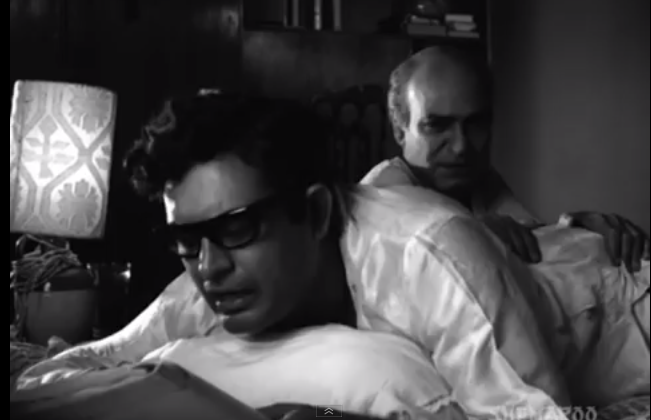My Mirror column:
In films as disparate as Rukh, Bareilly ki Barfi and A Death in the Gunj, games of masculinity are depressingly insistent on dividing men into winners and losers.
 |
| Rajkummar Rao in Bareilly ki Barfi |
 |
| Adarsh Gourav in Rukh |
A few months ago, watching Ashwini Iyer Tiwari’s Bareilly ki Barfi, I laughed along with the rest of the audience at the transformation of Rajkummar Rao’s character from a meek sari shop salesman to a rowdy, rude ‘rangbaaz’. Rao is a wonderfully talented actor, and there is much pleasure to be derived from watching the mousy, squeaky-voiced, easily bullied Pritam Vidrohi metamorphose, on the back of a few days’ ‘training’, into the sort of neighbourhood thug who might successfully bully the real Pritam. We watch, giggling, as the person we ‘know’ to be quaking internally acts out a certain kind of machismo — parking his motorcycle in the middle of a traffic filled road, ostensibly to buy himself a paan from a streetside shop, and then silencing a jeepful of outraged men with a mere wave of the hand.
The sequence is very funny, but it’s also an acute comment on what we respond to as manly behaviour. What is masculinity but the performance of it? Vidrohi's particular changeover involves a new haircut, a fashionable new jacket-clad look and a put-on Bachchan baritone. But it also depends on a change of body language, from a fluid, unspoken androgyny — one that made the old Vidrohi perfectly comfortable draping saris over himself for the benefit of prospective female clients — to a markedly masculine akad: a strutting display of the self, a performative occupying of space rather than an ability to adapt himself to it.
The sequence is very funny, but it’s also an acute comment on what we respond to as manly behaviour. What is masculinity but the performance of it? Vidrohi's particular changeover involves a new haircut, a fashionable new jacket-clad look and a put-on Bachchan baritone. But it also depends on a change of body language, from a fluid, unspoken androgyny — one that made the old Vidrohi perfectly comfortable draping saris over himself for the benefit of prospective female clients — to a markedly masculine akad: a strutting display of the self, a performative occupying of space rather than an ability to adapt himself to it.
Worse than this, though, is the fact that the reconfigured Vidrohi is someone who doles out unprovoked rudeness to anyone who might potentially be classed as his inferior in the social hierarchy: women (who may or not be his fans), waiters, anyone really. The alpha male, it seems, is needlessly aggressive, always competing, always out for himself — and despite all this, the heroine’s parents think there couldn't be a better man to marry their daughter. Obnoxiousness, it seems, is proof of successful masculinity.
Watching Atanu Mukherjee's debut feature Rukh last week, I found myself thinking of how the film circles around the same theme: what constitutes masculinity? Rukh's taut performances do not compensate for a shallow plot and not-very-thickly drawn characters. The deliberate gravitas of its silences could not be more different from Bareilly ki Barfi’s crowd-pleasing chatty comedy. But uneven as Rukh is, there are moments when it gets something just right, such as the scene where a lanky young man entering the murky world of real estate tells his friend why a gun is needed. Keep it empty, he says with an air of throwaway confidence. “Koi agar mich-mich karne lage, usko bas dikhane ka [If anyone makes a fuss about something, just show the gun].” Again, performance is all.
The other thing that struck me was Rukh’s toggling between good men and bad, questioning easy definitions of strength and weakness. It doesn’t quite succeed, but Mukherjee’s script seems to want to ask the question of what being a man means, and one of the things it concerns itself with is the idea of running away. At one level, it does this through Kumud Mishra’s character, the ‘friend’ and business partner who abandons ship when his own selfish actions threaten to sink it. At another level, the film forces us to think about whether suicide is necessarily an act of cowardice.
At a more literal level is a startling playground scene in which the teenaged protagonist Dhruv (Adarsh Gourav) retaliates to an unprovoked push with violence. The playground is a microcosm of the world, and it is no coincidence that we so often hear parents — more often fathers, but sometimes mothers — speak of how they want their children to be able to “give it back” if attacked. The capacity to return violence with violence, in this reading, is the ultimate marker of courage. But is it courage, or cowardice? When Dhruv’s father (Manoj Bajpayee) berates him with “And then you ran away!”, it is impossible not to be moved by Dhruv’s answer: “I got scared.”
 |
| Vikrant Massey in A Death in the Gunj |
These films all point to the fact that violence is the externalising of unprocessed fear. The more we applaud aggression in men, and discourage them from expressing hurt or grief or vulnerability, the more likely it is to spill over as violence, towards others and more rarely, towards themselves.
Published in Mumbai Mirror, 29 Oct 2017.










